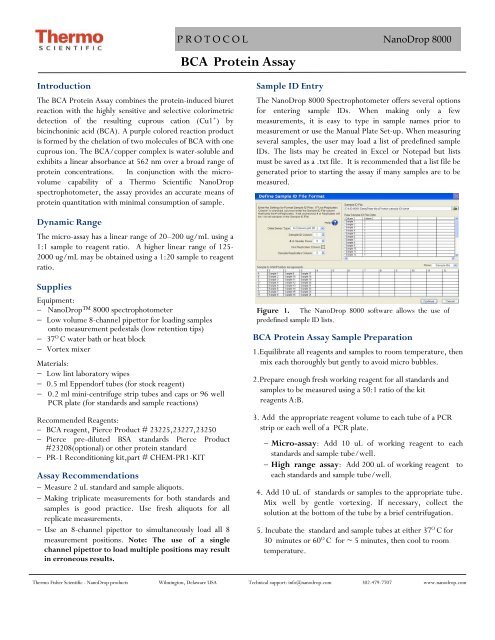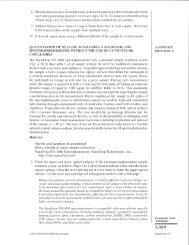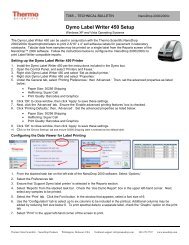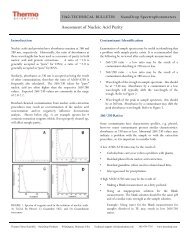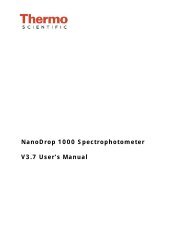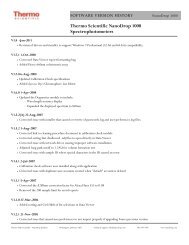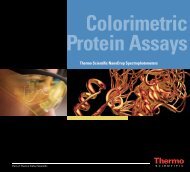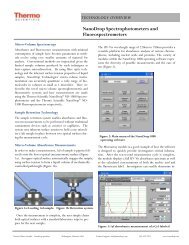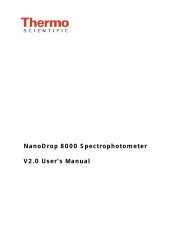BCA Protein Assay Protocol for the NanoDrop 8000
BCA Protein Assay Protocol for the NanoDrop 8000
BCA Protein Assay Protocol for the NanoDrop 8000
- No tags were found...
You also want an ePaper? Increase the reach of your titles
YUMPU automatically turns print PDFs into web optimized ePapers that Google loves.
PROTOCOL <strong>NanoDrop</strong> <strong>8000</strong><strong>BCA</strong> <strong>Protein</strong> <strong>Assay</strong>IntroductionThe <strong>BCA</strong> <strong>Protein</strong> <strong>Assay</strong> combines <strong>the</strong> protein-induced biuretreaction with <strong>the</strong> highly sensitive and selective colorimetricdetection of <strong>the</strong> resulting cuprous cation (Cu1 + ) bybicinchoninic acid (<strong>BCA</strong>). A purple colored reaction productis <strong>for</strong>med by <strong>the</strong> chelation of two molecules of <strong>BCA</strong> with onecuprous ion. The <strong>BCA</strong>/copper complex is water-soluble andexhibits a linear absorbance at 562 nm over a broad range ofprotein concentrations. In conjunction with <strong>the</strong> microvolumecapability of a Thermo Scientific <strong>NanoDrop</strong>spectrophotometer, <strong>the</strong> assay provides an accurate means ofprotein quantitation with minimal consumption of sample.Sample ID EntryThe <strong>NanoDrop</strong> <strong>8000</strong> Spectrophotometer offers several options<strong>for</strong> entering sample IDs. When making only a fewmeasurements, it is easy to type in sample names prior tomeasurement or use <strong>the</strong> Manual Plate Set-up. When measuringseveral samples, <strong>the</strong> user may load a list of predefined sampleIDs. The lists may be created in Excel or Notepad but listsmust be saved as a .txt file. It is recommended that a list file begenerated prior to starting <strong>the</strong> assay if many samples are to bemeasured.Dynamic RangeThe micro-assay has a linear range of 20–200 ug/mL using a1:1 sample to reagent ratio. A higher linear range of 125-2000 ug/mL may be obtained using a 1:20 sample to reagentratio.SuppliesEquipment:− <strong>NanoDrop</strong> <strong>8000</strong> spectrophotometer− Low volume 8-channel pipettor <strong>for</strong> loading samplesonto measurement pedestals (low retention tips)− 37 O C water bath or heat block− Vortex mixerMaterials:− Low lint laboratory wipes− 0.5 ml Eppendorf tubes (<strong>for</strong> stock reagent)− 0.2 ml mini-centrifuge strip tubes and caps or 96 wellPCR plate (<strong>for</strong> standards and sample reactions)Recommended Reagents:− <strong>BCA</strong> reagent, Pierce Product # 23225,23227,23250− Pierce pre-diluted BSA standards Pierce Product#23208(optional) or o<strong>the</strong>r protein standard− PR-1 Reconditioning kit,part # CHEM-PR1-KIT<strong>Assay</strong> Recommendations− Measure 2 uL standard and sample aliquots.− Making triplicate measurements <strong>for</strong> both standards andsamples is good practice. Use fresh aliquots <strong>for</strong> allreplicate measurements.− Use an 8-channel pipettor to simultaneously load all 8measurement positions. Note: The use of a singlechannel pipettor to load multiple positions may resultin erroneous results.Figure 1. The <strong>NanoDrop</strong> <strong>8000</strong> software allows <strong>the</strong> use ofpredefined sample ID lists.<strong>BCA</strong> <strong>Protein</strong> <strong>Assay</strong> Sample Preparation1.Equilibrate all reagents and samples to room temperature, <strong>the</strong>nmix each thoroughly but gently to avoid micro bubbles.2.Prepare enough fresh working reagent <strong>for</strong> all standards andsamples to be measured using a 50:1 ratio of <strong>the</strong> kitreagents A:B.3. Add <strong>the</strong> appropriate reagent volume to each tube of a PCRstrip or each well of a PCR plate.− Micro-assay: Add 10 uL of working reagent to eachstandards and sample tube/well.− High range assay: Add 200 uL of working reagent toeach standards and sample tube/well.4. Add 10 uL of standards or samples to <strong>the</strong> appropriate tube.Mix well by gentle vortexing. If necessary, collect <strong>the</strong>solution at <strong>the</strong> bottom of <strong>the</strong> tube by a brief centrifugation.5. Incubate <strong>the</strong> standard and sample tubes at ei<strong>the</strong>r 37 O C <strong>for</strong>30 minutes or 60 O C <strong>for</strong> ~ 5 minutes, <strong>the</strong>n cool to roomtemperature.Thermo Fisher Scientific - <strong>NanoDrop</strong> products Wilmington, Delaware USA Technical support: info@nanodrop.com 302-479-7707 www.nanodrop.com
2PROTOCOL <strong>NanoDrop</strong> <strong>8000</strong><strong>Protocol</strong>1. Clean pedestals by pipetting 2 uL of dH 2 O onto each all 8lower pedestals, and lowering <strong>the</strong> arm so that <strong>the</strong> watermakes contact with both <strong>the</strong> upper and lower measurementsurfaces. Raise <strong>the</strong> arm and wipe all pedestals with a drylaboratory wipe.2. Launch <strong>the</strong> <strong>NanoDrop</strong> <strong>8000</strong> software and open <strong>the</strong><strong>Protein</strong> <strong>BCA</strong> module.3. Initialize <strong>the</strong> instrument by loading 2 uL of dH 2 O to all 8lower pedestals, lower <strong>the</strong> arm and click OK. When initializationis complete, use a dry laboratory wipe to wipe<strong>the</strong> water from all measurement surfaces.4. From <strong>the</strong> Standards Choose Source window select <strong>the</strong>standard curve source. It is recommended that new standardabsorbance values be measured each time <strong>the</strong> assay isrun. Manually enter standard concentration values or entera concentration series using a previously stored standardcurve. If using a preloaded standard curve, continue tostep 7.8. Gently mix <strong>the</strong> samples and use an 8-channel pipettor tosimultaneously load multiple pedestal positions. Use fresh2 uL aliquots <strong>for</strong> each replicate.9. After completing all <strong>the</strong> measurements, re-condition <strong>the</strong>pedestals with PR-1.Per<strong>for</strong>mance DataBSA(µg/mL) A562 (n=5) St dev %CV0 .001 .002 NA125 .011 .003 NA250 .03 .001 3.28500 .062 .002 3.13750 .092 .002 2.141000 .119 .002 1.351500 .169 .003 1.672000 .218 .002 0.89Table 1. Typical per<strong>for</strong>mance data <strong>for</strong> <strong>the</strong> high range <strong>BCA</strong>protein assay using a BSA Standard Curve.Typical <strong>BCA</strong> Sample SpectraFigure 2. The <strong>NanoDrop</strong> <strong>8000</strong> software allows <strong>the</strong> use of apredefined standard curve or <strong>the</strong> user may build a new curve.5. Use an 8-channel pipettor to transfer 2 uL of dH20 ontoeach of <strong>the</strong> 8 lower pedestals. Lower <strong>the</strong> arm and clickBlank. When <strong>the</strong> measurement is complete wipe <strong>the</strong> pedestalswith a lab wipe.6. Gently mix <strong>the</strong> standards, <strong>the</strong>n use a 8-channel pipettor tosimultaneously load <strong>the</strong> reference (reagent and buffer, noprotein) and standards to generate a new standard curve.Use fresh 2 uL aliquots to measure additional replicates.Figure 3. Example spectrum of <strong>BCA</strong> reagent-<strong>Protein</strong> sample.7. Select <strong>the</strong> sample ID loading mode when prompted. Referto page 1 <strong>for</strong> additional details.For additional in<strong>for</strong>mation regarding <strong>the</strong> <strong>BCA</strong> assay and reagents, referto http://www.piercenet.com.T067/ Rev 10/2/09Thermo Fisher Scientific - <strong>NanoDrop</strong> products Wilmington, Delaware USA Technical support: info@nanodrop.com 302-479-7707 www.nanodrop.com


